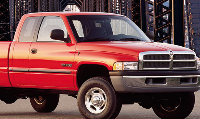loaded caliper pulls on hard braking
#1
Good morning everyone,
I replaced only the passenger caliper and pads, after getting a faulty one that leaked, (bad threads), and now my truck pulls increasing harder to the right towards the end of stopping. So if i am pulling up to a light it is fine until about the last 25 feet when it pulls further to the right the closer to complete stop. I am thinking that the new pads need to get worn down a bit to the groves of the rotors, so it has more friction than the slightly warn pads on the drivers side. I replaced the rotors 3 months ago along with the original new loaded calipers. Any thoughts?
Thanks,
Kevin
I replaced only the passenger caliper and pads, after getting a faulty one that leaked, (bad threads), and now my truck pulls increasing harder to the right towards the end of stopping. So if i am pulling up to a light it is fine until about the last 25 feet when it pulls further to the right the closer to complete stop. I am thinking that the new pads need to get worn down a bit to the groves of the rotors, so it has more friction than the slightly warn pads on the drivers side. I replaced the rotors 3 months ago along with the original new loaded calipers. Any thoughts?
Thanks,
Kevin
#2
3 months ago you replaced your front rotors, calipers, and pads. You have a bad caliper and now you replaced calipers and pads on one side. Is that right? How many miles did you drive in 3 months? Why didn't you just put the 1st replacement pads back on so they'd match the other side? You think the ones that are not worn in are biting better than worn in pads?
If you didn't put too many miles on, I highly doubt those pads are causing the problem unless they are a different pad. Might also check the driver's side if it is not bled all the way or if it is not moving freely.
If you didn't put too many miles on, I highly doubt those pads are causing the problem unless they are a different pad. Might also check the driver's side if it is not bled all the way or if it is not moving freely.
#3
I think you are right about the re-bleeding, cause I feel like the brakes worked fine initially, but as the air has worked its way into the drivers side lines it is getting worse. And I wish I grabbed the old pads, I got a free return at Napa and didn't think to take off the old pads. I am still a novice at this mechanic stuff so I just figured they knew more than me in that regards.
#5
I had new pads (supposedly) on my truck when I bought it in Sept. It pulled hard to the left exactly the same way you're describing. After replacing everything you see in my sig, it ended up being the "new" pads. Since they were new, I figured it couldn't possibly be them... but when I finally replaced them the problem was resolved.
I'd say just go drop the 30-40 bucks on some decent semimetallic pads (I got the Gold ones at Advance) and it likely will resolve the problem.
Just my $0.02
I'd say just go drop the 30-40 bucks on some decent semimetallic pads (I got the Gold ones at Advance) and it likely will resolve the problem.
Just my $0.02
#7
Trending Topics
#9
pads should always be done in sets to avoid uneven wear. rotors should also be turned at each brake job, or replaced if they are under specs.
Front brake pull condition could result from:
Contaminated lining in one caliper
Seized caliper piston
Binding caliper
Loose caliper
Rusty adapter/caliper slide surfaces
Improper brakeshoes
Damaged rotor
A worn, damaged wheel bearing or suspension component are further causes of pull. A damaged front tire (bruised, ply separation) can also cause pull.
A common and frequently misdiagnosed pull condition is where direction of pull changes after a few stops. The cause is a combination of brake drag followed by fade at one of the brake units.
As the dragging brake overheats, efficiency is so reduced that fade occurs. Since the opposite brake unit is still functioning normally, its braking effect is magnified. This causes pull to switch direction in favor of the normally functioning brake unit.
An additional point when diagnosing a change in pull condition concerns brake cool down. Remember that pull will return to the original direction, if the dragging brake unit is allowed to cool down (and is not seriously damaged)
Front brake pull condition could result from:
Contaminated lining in one caliper
Seized caliper piston
Binding caliper
Loose caliper
Rusty adapter/caliper slide surfaces
Improper brakeshoes
Damaged rotor
A worn, damaged wheel bearing or suspension component are further causes of pull. A damaged front tire (bruised, ply separation) can also cause pull.
A common and frequently misdiagnosed pull condition is where direction of pull changes after a few stops. The cause is a combination of brake drag followed by fade at one of the brake units.
As the dragging brake overheats, efficiency is so reduced that fade occurs. Since the opposite brake unit is still functioning normally, its braking effect is magnified. This causes pull to switch direction in favor of the normally functioning brake unit.
An additional point when diagnosing a change in pull condition concerns brake cool down. Remember that pull will return to the original direction, if the dragging brake unit is allowed to cool down (and is not seriously damaged)
Last edited by motorbrreath; 01-04-2009 at 06:54 PM. Reason: corrected by ophidia.



